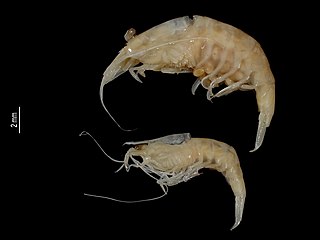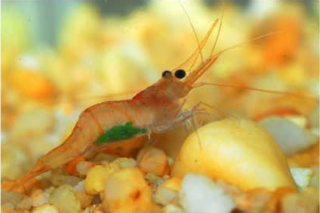
Yilong Lake is a large freshwater lake located in Shiping County, Honghe Prefecture, Yunnan province, southwestern China. The lake has a surface area of approximately 32 square kilometres (12 sq mi) and is particularly notable for its scenery, including the colorful lotus flowers that bloom on its surface. It is located about 2 kilometres (1.2 mi) east of the county seat. The people who live in the vicinity of the lake are largely of the Yi ethnic group. As of the spring of 2013 a severe drought had resulted in substantial lowering of the water level.

Caridina nilotica is a species of freshwater shrimp in the family Atyidae. It is native to Africa from the River Nile in Egypt to Lake Sibaya, South Africa, and is the only species of shrimp in Lake Victoria.

Caridina dennerli is a small species of freshwater shrimp from Sulawesi (Indonesia) that grows up to 2.5 centimetres (1.0 in) in length. It takes its name from the German company Dennerle, which supported the expedition that led to the scientific description of the species. It is popularly known as the 'cardinal shrimp' in the aquarium trade.

Caridina spongicola is a small species of freshwater shrimp from Sulawesi (Indonesia) that reaches 0.64 to 1.27 cm in length. In the wild it strictly lives on an undescribed species of freshwater sponge, making it one of only two known commensal species of freshwater shrimp. It is popularly known as the harlequin shrimp, and also sometimes Celebes beauty shrimp or sponge shrimp in the aquarium trade. It is often confused with Caridina woltereckae, a larger and more contrastingly colored species found in the same region as C. spongicola.

Parathelphusa pantherina, commonly known as the "panther crab", is a variety of freshwater crab from Indonesia from the family of the Gecarcinucidae. The scientific name of the species was published for the first time in 1902 by Schenkel. The species is categorized as Endangered by IUCN Red List due to damage to their habitat by mining of nickel from lake shores where they live, which negatively impacts their water quality.

Caridina woltereckae, or Sulawesi harlequin shrimp as it is commonly known in the aquarium hobby, is a freshwater shrimp from Sulawesi, Indonesia. It is endemic to Lake Towuti. It resembles the smaller and less contrastingly coloured Caridina spongicola, which is endemic to the same lake.
Caridina striata is a freshwater shrimp from Sulawesi. It is endemic to Lake Poso and Lake Towuti. Common names in the aquarium hobby are red line shrimp and red stripe shrimp. It is commonly found on rocky substrates.
Caridina spinata, or yellow goldflake as it is commonly known in the aquarium hobby, is a freshwater shrimp from Sulawesi. It is endemic to Lake Towuti. It lives on rocky substrates.
Caridina ensifera is a freshwater shrimp from Sulawesi. It is one of the 11 species of Caridina endemic to Lake Poso. It lives on a variety of substrates, including wood, rocks, sand and macrophytes, but is also found in pelagic swarms. It is suspected to only live in shallow water.

Caridina caerulea is a freshwater shrimp from Sulawesi. It is one of 11 species in the genus Caridina that is endemic to Lake Poso. It lives on a variety of substrates, including wood, rocks, sand and macrophytes. It is suspected only to live in shallow water.

Caridina loehae is a freshwater shrimp from Sulawesi. It is known as mini blue bee and orange delight shrimp in the aquarium trade. It is endemic to the Malili lake system. It lives on rocky substrates at a maximal depth of 5 metres.

Caridina simoni is a freshwater shrimp found widespread in Sri Lanka and Tamil Nadu, India. The Indian population was originally described as Caridina kunnathurensis by Richard & Chandran in 1994, but was later identified to be the same species. It is found in a diversity of habitats, including both rivers and lakes.
Caridina masapi is a freshwater shrimp from Sulawesi. The species is endemic to the Malili lake system. It is commonly found on rocky substrate.
Caridina semiblepsia is a cave dwelling freshwater shrimp from China. It is only known from one location: the Baojing Cave in the province of Hunan.
Caridina yilong is a species of freshwater shrimp in the family Atyidae. C. yilong was described from Lake Yilong in Yunnan, China, and was believed to be endemic to the margins of the lake among fringing vegetation. Only the type series has ever been collected, and the type locality of Lake Yilong has since dried up for extended periods of time due to the abstraction of water. Organic pollution caused by sedimentation along with agricultural and industrial pollution has caused this species to be assessed as Critically Endangered by the IUCN, with the caveat possibly extinct. In addition, two species of fish, Anabarilius macrolepis and Cyprinus yilongensis, that also were endemic to the lake are now extinct.

Caridina linduensis is a species of freshwater shrimp in the family Atyidae, endemic to Lake Lindu and its effluent stream in Sulawesi. It was known only from the type series, collected in 1904, and was recorded again in 2011 in a survey around Lake Lindu and is found in shallow littoral habitats of leaf litter, macrophytes, and dead wood. In the effluent stream it is found on soft substrates and slow flowing water, and is less common in the lake itself. The type locality of Lake Lindu was designated as a Recreation Park in 1978, and is part of the larger Lore Lindu National Park and UNESCO Biosphere Reserve. It is listed under IUCN criterion B1ab(iii,v) as Critically Endangered due to threats from introduced species of fish, land conversion to agriculture, logging, and shore disturbance caused by the grazing of water buffalo. Surveys are required to find the full distribution of C. linduensis, primarily its habitat in the effluent stream. C. linduensis is also sympatric with the recently described species Caridina dali and Caridina kaili.

Caridina glaubrechti is species of lacustrine fresh water shrimp endemic to western part of Lake Towuti on the Indonesian island of Sulawesi. It is named in honor of German Zoologist Matthias Glaubrecht.

Caridina profundicola is species of fresh water shrimp endemic to Lake Towuti on the Indonesian island of Sulawesi.

Caridina holthuisi is a species of freshwater shrimp in the family Atyidae, endemic to the Malili lake system in Sulawesi, Indonesia. It can be found in Lake Towuti, Lake Matano, and Lake Mahalona, as well as the Petea river. It is named in honour of Dutch carcinologist, Lipke Holthuis.













